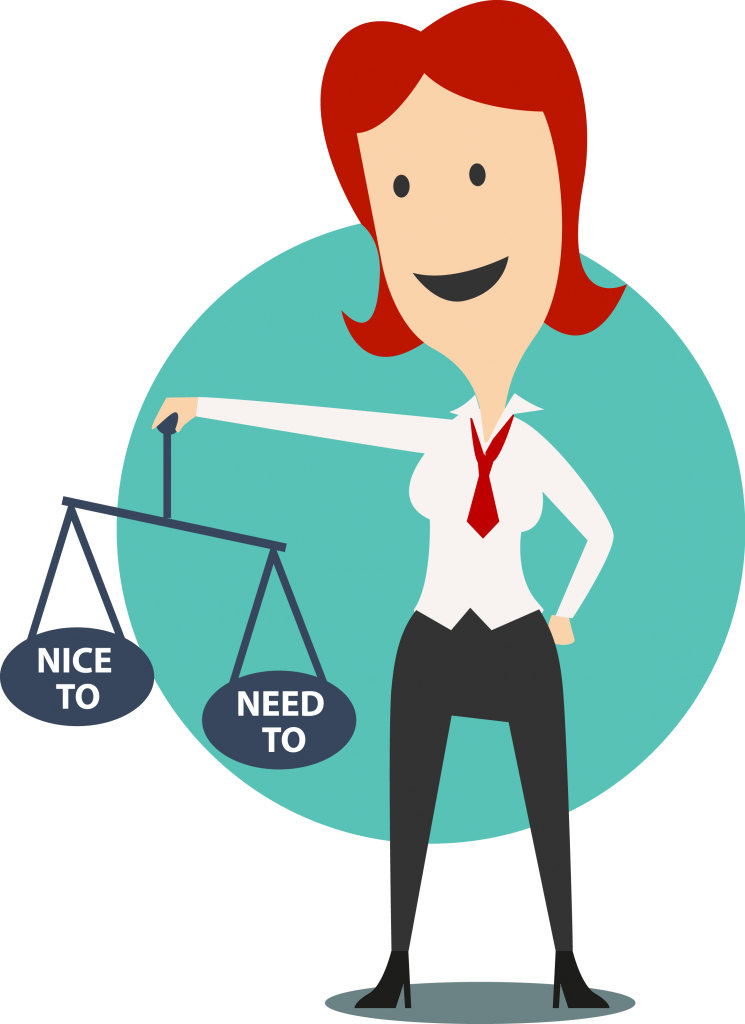Six ways to distinguish ‘nice to haves’ from ‘need to haves’ when planning a training programme

We all know that sinking feeling when presented with a slide deck and told to ‘turn it into training’. While the subject matter expert probably thinks it’ll be a quick job, we know differently – it’s going to need cutting, chunking, editing, animating… and that’s after working out what the content is about. It’s no easy task.
However, the alternative – content-heavy learning materials that are labour-intensive to produce and don’t lead to change – is worse. In the short term, it frustrates learners and wastes their time, and ultimately it undermines our value as learning and development professionals.
In this post, I’ll outline how to regain control over those ‘just turn this into training’ projects. The key is to trim the ‘nice to have’ content away to leave the ‘need to have’ nuggets of impact-making content behind.
1. Set subject matter experts’ expectations
You’re going to need your subject matter expert’s (SMEs) help in sorting out your content, so get him or her on board with their mission from the start. Explain that learning development is a team effort, with the SME offering expertise on the facts and the ‘why’ of the training, and you as learning designer being the expert on how to make it make a difference.
2. Ask ‘What do you want people to do?’
This is the question that catches many SMEs out, especially if they’re new to their role or to learning projects. Often, they haven’t thought about it at all: they see training as being about knowledge, not action.
One way to approach the topic is to tweak the angle. Ask the classic consultants’ question: ‘What does success look like to you?’ This focus on impact can shift the SME’s mindset into a business-orientated one. Your questions can continue in the same vein: ‘How will you know that the training has been successful? What will people be doing differently? What will they not be doing?’
3. Make it measurable
Things get a lot easier once you have a sense of what the business wants to achieve from the training. For one thing, the SME will likely see its value, and for another, you can start to create some goals that can be measured to show the impact of the learning. But once again, you’ll need your SME on board.
Here’s where their knowledge of the organisation’s strategy helps. Ask your SME for the measurable goals they’re working towards and ask them for similar goals for the training you’re working on together.
You’re aiming to leave this meeting with a statement that you and your SME have agreed upon and that contains the following:
- What the SME wants people to be doing differently as a result of the training
- How this will be measured
- A deadline by which the change will happen.
Internationally recognised training designer Cathy Moore has developed a wide range of resources to help you through these steps, including downloadable diagrams to use with your SME.
4. Align content with goals
Now it’s your turn to get working on the content. Using the goals your SME has provided, align the information within the content you already with the goals. Anything that doesn’t align with the goals is nice to have, not need to have.
5. Do a sense check
As we all know, when it comes to learning content, you can look at it too many times. When this happens, we overlook what’s right in front of us – including whether it’s likely to be effective or not.
Ideally at this point, get a colleague involved to check whether the content aligns with the agreed goals, but if you’re a team of one then ask yourself the following question: Could people do what is required of them without having that piece of information?
If the answer is yes, then that information is a nice to have.
6. Pare it down
Your knowledge of your learners comes into its own now. With many learners wanting ‘just in time’ learning, it’s your task to transform the content into material that learners can access as and when they need it. Whether that’s via eLearning, videos, podcasts or short face-to-face sessions, you’ll know best.
In summary
Stick to your guns and ask the right questions. Your programme should be based on the application of knowledge and skills that will result in the desired behaviour – remember, it’s all about what they need to do.
We all know that sinking feeling when presented with a slide deck and told to ‘turn it into training’. While the subject matter expert probably thinks it’ll be a quick job, we know differently – it’s going to need cutting, chunking, editing, animating… and that’s after working out what the content is about. It’s no easy task.

However, the alternative – content-heavy learning materials that are labour-intensive to produce and don’t lead to change – is worse. In the short term, it frustrates learners and wastes their time, and ultimately it undermines our value as learning and development professionals.
In this post, I’ll outline how to regain control over those ‘just turn this into training’ projects. The key is to trim the ‘nice to have’ content away to leave the ‘need to have’ nuggets of impact-making content behind.
1. Set subject matter experts’ expectations
You’re going to need your subject matter expert’s (SMEs) help in sorting out your content, so get him or her on board with their mission from the start. Explain that learning development is a team effort, with the SME offering expertise on the facts and the ‘why’ of the training, and you as learning designer being the expert on how to make it make a difference.
2. Ask ‘What do you want people to do?’
This is the question that catches many SMEs out, especially if they’re new to their role or to learning projects. Often, they haven’t thought about it at all: they see training as being about knowledge, not action.
One way to approach the topic is to tweak the angle. Ask the classic consultants’ question: ‘What does success look like to you?’ This focus on impact can shift the SME’s mindset into a business-orientated one. Your questions can continue in the same vein: ‘How will you know that the training has been successful? What will people be doing differently? What will they not be doing?’
3. Make it measurable
Things get a lot easier once you have a sense of what the business wants to achieve from the training. For one thing, the SME will likely see its value, and for another, you can start to create some goals that can be measured to show the impact of the learning. But once again, you’ll need your SME on board.
Here’s where their knowledge of the organisation’s strategy helps. Ask your SME for the measurable goals they’re working towards and ask them for similar goals for the training you’re working on together.
You’re aiming to leave this meeting with a statement that you and your SME have agreed upon and that contains the following:
- What the SME wants people to be doing differently as a result of the training
- How this will be measured
- A deadline by which the change will happen.
Internationally recognised training designer Cathy Moore has developed a wide range of resources to help you through these steps, including downloadable diagrams to use with your SME.
4. Align content with goals
Now it’s your turn to get working on the content. Using the goals your SME has provided, align the information within the content you already with the goals. Anything that doesn’t align with the goals is nice to have, not need to have.
5. Do a sense check
As we all know, when it comes to learning content, you can look at it too many times. When this happens, we overlook what’s right in front of us – including whether it’s likely to be effective or not.
Ideally at this point, get a colleague involved to check whether the content aligns with the agreed goals, but if you’re a team of one then ask yourself the following question: Could people do what is required of them without having that piece of information?
If the answer is yes, then that information is a nice to have.
6. Pare it down
Your knowledge of your learners comes into its own now. With many learners wanting ‘just in time’ learning, it’s your task to transform the content into material that learners can access as and when they need it. Whether that’s via eLearning, videos, podcasts or short face-to-face sessions, you’ll know best.
In summary
Stick to your guns and ask the right questions. Your programme should be based on the application of knowledge and skills that will result in the desired behaviour – remember, it’s all about what they need to do.
Want to know more about how we can help your organisation maximise its return on investment in learning and development?
Contact us for a no-obligations discussion.

